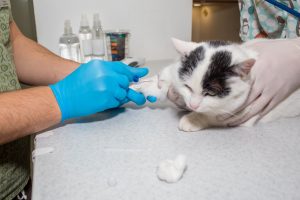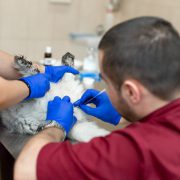Smaller-gauge catheters and greater body weights are associated with increased risk of peripheral intravenous catheter complications in cats hospitalized in the critical care unit
Smaller-gauge catheters and greater body weights are associated with increased risk of peripheral intravenous catheter complications in cats hospitalized in the critical care unit

Open access
In our edition of: Jun 2024
In our categories of: small animals
our summary:
Granger, K.L., Zersen, K.M. and Guieu, L. (2024) Smaller-gauge catheters and greater body weights are associated with increased risk of peripheral intravenous catheter complications in cats hospitalized in the critical care unit. Journal of the American Veterinary Medical Association, 37 (7), pp. 342-346.
The aim of this prospective, observational study was to identify risk factors associated with peripheral intravenous catheter (PIVC) complications in cats hospitalised in the critical care unit (CCU) at a veterinary teaching hospital in the United States. The authors hypothesised that longer PIVC dwell time, increasing length of hospitalisation, smaller-gauge PIVC, and insertion site would be risk factors for complications.
Cats attending the teaching hospital between October 2022 and September 2023 that had a PIVC placed in either the urgent care or CCU and were hospitalised in the CCU for at least 24 hours were eligible for inclusion in the study. Placement of all PIVCs was carried out by trained personnel following the study’s standardised protocol, selection of PIVC size and length was based on the trained personnel’s clinical judgement of the patient and the vessel size.
Monitoring of PIVCs was carried out twice daily by the same person and included visual examination of the limb for swelling, manual palpation of the limb above and below the PIVC insertion site and inspection of the PIVC insertion site. Complications were classified as extravasation, phlebitis, dislodgement, occlusion, line breakage, or patient removal. Patient demeanour and PIVC dwell time were also recorded. Only data related to the first PIVC placed were included for analysis.
A total of 120 PIVCs were included in the study. The most commonly recorded reasons for hospitalisation were renal/urogenital (40), gastrointestinal/hepatobiliary (29), haematologic (14) and respiratory diseases (9).
The overall PIVC complication rate was 22/120 (18.3%), with extravasation (7/120, 5.8%) and dislodgment (7/120, 5.8%) being the most frequently recorded complications. Multivariable analysis found increase in patient body weight and smaller PIVC catheter size (22-gauge vs 20-gauge) were significant risk factors for PIVC complication.
Limitations of the study are the small sample size for analysis of complications, the small number of 22-gauge PIVCs included and that the study was based on a specific PIVC standardised protocol in a CCU at a veterinary hospital which may not be generalisable to other populations of cats.
This study provides some evidence that smaller PIVC (22-gauge) and having a greater body weight are risk factors for PIVC complications in hospitalised cats. Future studies with a larger sample size involving a more even distribution of catheter gauges and recording of other factors including patient behaviour and sedation are needed.
The following may also be of interest:
Bush, K. et al. (2020) Peripheral intravenous catheter complications in hospitalized cats: an observational pilot study. Topics in Companion Animal Medicine, 41, p.100456. https://doi.org/10.1016/j.tcam.2020.100456
Ashby, J. (2017) Peripheral intravenous catheter care in hospitalised cats and dogs. Veterinary Nursing Journal, 32 (2), pp. 32-36. https://doi.org/10.1080/17415349.2016.1262322
Peripheral catheter care and phlebitis score [RCVS Knowledge][online]. Available from: https://knowledge.rcvs.org.uk/document-library/peripheral-catheter-care-and-phlebitis-score/ [Accessed 24 June 2024]
Peripheral catheter checklist and audit case example [RCVS Knowledge][online]. Available from: https://knowledge.rcvs.org.uk/document-library/peripheral-catheter-checklist-and-audit-case-example/ [Accessed 24 June 2024]
Claiming CPD for reading inFOCUS articles
Reading and reflecting on articles can count towards your CPD, and we have a template to help you with the process.
Image copyright attribute: artemenkodaria





Leave a Reply
Want to join the discussion?Feel free to contribute!